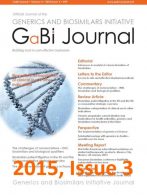GENERICS AND BIOSIMILARS INITIATIVE JOURNAL
Official Journal of the Generics and Biosimilars Initiative
Volume 4 / Year 2015 / Issue 3
Published articles:
- 2015/3 GaBI Journal Table of Contents (1)
- Commentary (1)
- Editor's Letter (1)
- Editorial (1)
- Letters to the Editor (1)
- Meeting Report (2)
- Perspective (2)
- Regulatory (1)
- Review Article (3)



